
Metaverse Meetings: Spatial Computing – A New Dimension in Digital Communication
Content
In the rapidly evolving landscape of technology, communication has reached a new dimension, thanks to Spatial Computing. This groundbreaking concept of machine interaction is redefining how we connect, and engage with the digital world.
In this blog, we’ll embark on a journey to explore the fusion of Spatial Computing and communication, understanding its profound impact on brand communication boosting customer success, and the way we engage with audiences.
No deep neural networks or digital twins voodoo, but full knowledge of why sound is crucial for the spatial web.
Introduction to Spatial Computing Communication
At its core, Spatial Computing is the bridge that seamlessly connects the physical and digital realms. It’s the technology that enables us to interact with computer-generated elements in a unified digital space as if they were part of our real physical world.
Through Spatial Computing, we create immersive virtual environments where communication takes on a new depth and richness and can even go beyond real-life communication. This includes the evolution of business meetings in the context of virtual reality, where 3D virtual business meetings provide a more immersive and engaging experience compared to traditional 2D virtual business meetings.
-
Imagine having a virtual meeting where colleagues from different parts of the world feel like they’re in the same room, sharing ideas, connecting socially, and collaborating naturally.
-
Picture exploring a virtual art gallery, where you can appreciate artwork in different layers and from virtually every angle, just as if you were physically present.
These scenarios illustrate the transformative potential of Spatial Computing as a communication medium.
More details about communication in the metaverse can be found with this link.
Spatial Computing is poised to revolutionize the way we shop. Imagine stepping into a virtual boutique, browsing through racks of clothing, virtually trying on various outfits, and discussing them with your friends – all from the comfort of your own home.
With the ability to customize and configure products to individual tastes, this amalgamation of simulation and real-life shopping offers an unparalleled level of convenience and personalization.
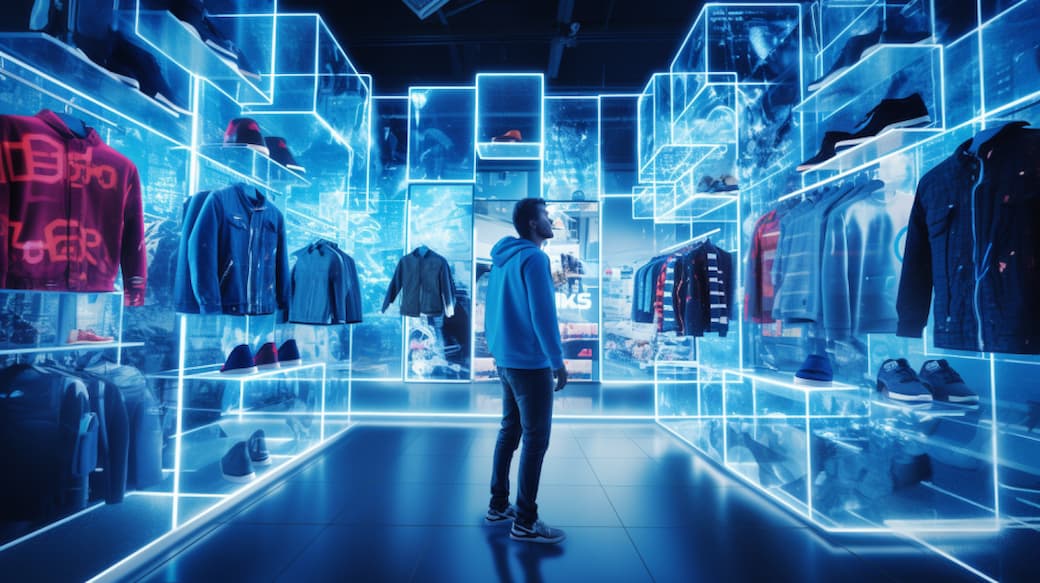
It’s a glimpse into a future where the boundaries between physical and digital retail spaces blur, providing an extraordinary shopping experience that transcends conventional norms.
Its Impact on Brand Communication
As the digital and physical worlds merge within Spatial Computing environments, brands are presented with a unique opportunity to reinvent the way they communicate.
Traditional advertising and marketing are evolving into immersive brand experiences and immersive environments that captivate and engage audiences in unprecedented ways. Virtual offices, as part of these immersive brand experiences, serve as digital representations of physical workspaces that enhance remote work experiences.
Together, we’ll navigate the uncharted territories of this transformative technology and its role in shaping the future of communication.
Learn how spatial audio can be used for brands in marketing.
What Is Spatial Computing? Definition and Virtual Reality
Spatial Computing is not just a buzzword; it’s a technological marvel that’s poised to revolutionize the way we communicate and how humans interact in metaverse environments.
For me it is fairly similar to immersive technologies like virtual reality, augmented reality and mixed reality, extended reality applications, and the metaverse. But what exactly is Spatial Computing?
It is a technological framework that allows us to perceive, navigate, and interact with digital content as if it were augmented reality or an integral part of our mixed reality.
This technology allows users to interact with digital elements in virtual environments in a natural and intuitive way, similar to how we interact with humans in metaverse environments. Otherwise, we’re only used to 2D surfaces and tiles from computers. Pretty abstract when you think about it.
It’s more than just visual user interface enhancements; it includes spatial audio, 3D interfaces, spatial tools, and responsive environments that react to our movements and gestures.
Evolution of Digital Communication
The evolution of digital communication has transformed the way we interact and collaborate with each other. From traditional phone calls to video conferencing, and now to virtual reality meetings, technology has enabled us to connect with others in more immersive and engaging ways.
The metaverse, a virtual world where users can interact with each other and their environment in real-time, is the latest frontier in digital communication. Virtual meetings in the metaverse offer a unique opportunity for businesses to connect with their teams, clients, and partners in a more interactive and engaging way.
Imagine stepping into a virtual office where you can brainstorm with colleagues, present to clients, or even host large-scale conferences, all within a richly detailed virtual environment.
This shift from traditional video conferencing to virtual reality meetings in the metaverse is not just a technological upgrade; it’s a paradigm shift in how we perceive and engage in digital communication. The immersive nature of these virtual spaces allows for more natural interactions, fostering a sense of presence and connection that traditional video conferencing tools often lack.
Spatial operating system in modern times
In the ever-evolving landscape of modern communication, computer systems play a pivotal role. It’s not just a technological novelty; it’s a game-changer that’s shaping the way we connect with others and information. Here’s why Spatial Computing is relevant in contemporary communication:
Immersive Experiences
Spatial computing offers immersive and engaging experiences that go beyond the limits of traditional communication methods. But when is an experience even immersive? That’s hard to measure and define.
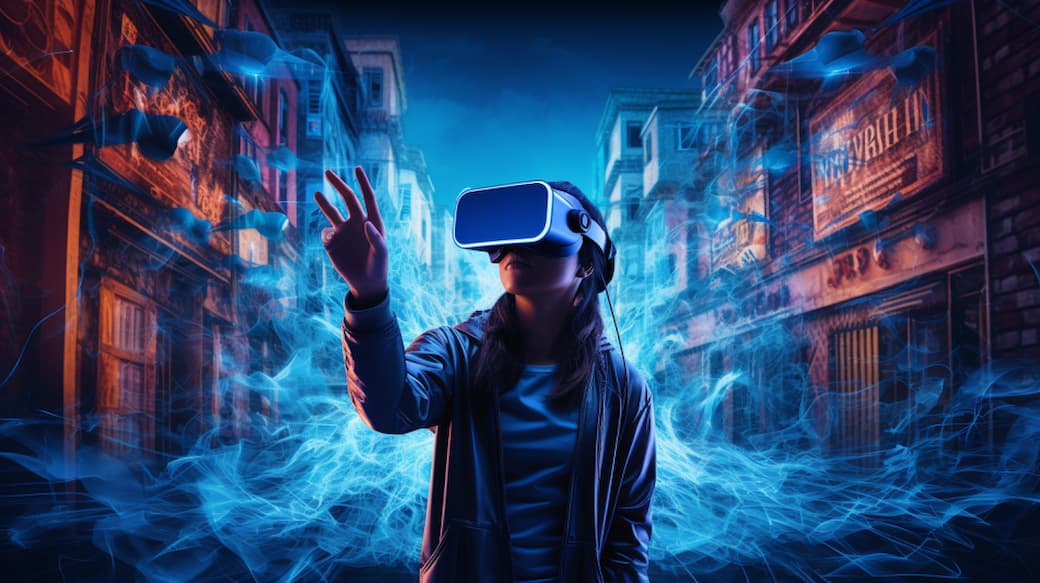
Virtual workstations play a crucial role in enhancing collaboration within metaverse meetings by allowing participants to utilize digital assets and engage with 3D objects. Just because you use VR or spatial computing related technologies, I don’t think you have guaranteed content of immersion in the end.
It has to be a visually, auditorily and storytelling or user experience engaging world. This applies to every industry, whether it’s entertainment or learning content – Spatial computing takes engagement to a new level.
Natural Interaction with digital and physical worlds
In today’s communication, we seek natural and intuitive interactions. Spatial Computing delivers on this front by allowing us to communicate with digital elements and avatars in ways that feel second nature.
It responds to our gestures, voice commands, and body movements, making communication seamless and enjoyable.
Spatial Audio
Sound is an integral part of communication, and Spatial Computing acknowledges this with spatial audio. It recreates 3D soundscapes, realistic room acoustics and 3D spatialized sound enveloping the users in a rich auditory experience.
True spatial audio enhances the depth and presence of communication, making it more immersive, social and engaging.
Beyond the Flat Screen
Traditional communication often takes place on flat-screen desktop computers, limiting our interaction.
Still spatial audio can be used in virtually every industry within video calls.
Spatial Computing breaks free from these constraints, offering three-dimensional user interfaces and smart glasses that provide a more comprehensive view of digital content. It’s a step closer to the future of communication in XR environments. Companies can even create their own virtual world, a personalized environment within the metaverse, for meetings and collaboration.
The Apple Vision Pro introduces a lot of 2D screens but I don’t think this is where the potential lies in this engaging format. Not to forget magic leap that are still relevant and closely related in the XR space.
In the next section, we’ll dive deeper into the practical applications of Spatial Computing in the healthcare sector and the corporate world, shedding light on how businesses across the construction world are leveraging this technology for enhanced communication and branding.
Limitations of Traditional Video Conferencing Tools
Traditional video conferencing tools have been widely adopted by businesses for remote meetings and collaboration. However, these tools have several limitations. They lack the immersive and interactive features of virtual reality meetings, which can lead to a sense of disconnection and fatigue.
Traditional video conferencing platforms also often require participants to be physically present in front of a camera, which can be distracting and limiting. In contrast, virtual reality meetings in the metaverse offer a more immersive and interactive experience, allowing participants to engage with each other and their environment in a more natural way.
In traditional video conferencing, the flat screen and limited interaction can make it challenging to maintain engagement and foster genuine connections. Participants may find it difficult to read body language or feel truly present in the meeting. This can lead to what is often referred to as “video conferencing fatigue.”
On the other hand, virtual reality meetings in the metaverse provide a three-dimensional space where participants can move around, interact with objects, and communicate more naturally. This immersive meeting experience can significantly enhance collaboration and productivity, making virtual reality a compelling alternative to traditional video conferencing tools.
Corporate Applications and use-cases
The corporate landscape is evolving with Spatial Computing leading the way, transforming business operations, communication and enables employees
-
Enhanced Virtual Meetings: Spatial Computing redefines virtual meetings, offering immersive 3D interactions, reducing fatigue effects and enhances productivity and satisfaction. Brainstorming sessions become more dynamic and collaborative in the metaverse, as virtual platforms create immersive environments that facilitate idea generation and project collaborations among team members.
-
Training and Simulations: VR training simulations are made possible, benefiting healthcare and industrial sectors to improve remote collaboration.
-
Architectural Visualization: Architects visualize projects in 3D, testing their room acoustics in 3D improving communication and decision-making by creating realistic digital twins

Successful Brand Integration:
-
Retail and E-Commerce: Virtual shopping enhances engagement.
-
Automotive Industry: Interactive showrooms create emotional connections.
-
Real Estate: Virtual property tours boost customer engagement.
-
Entertainment and Content: experiences make brands memorable like virtual concerts
Perfect Human Communication in Spatial Computing Revolution
In the realm of Spatial Computing, human communication via spatial computing takes web communication to a whole new dimension. A great example of next-gen spatial audio computing is atmoky.
It stands at the forefront, redefining the way we engage with audio and voice communication via spatial computing on the 3D web. Atmoky’s new spatial audio and 3D voice communication service Engage can be integrated by web platforms and apps for the highest immersive and realistic sounding experiences.
What makes a virtual environment sound good
Outstanding Spatial Audio
Spatial audio isn’t just a term; it’s an immersive experience. It goes beyond typical stereo sound, offering a full 3D representation of audio. With atmoky Engage spatial audio, you’re enveloped in a realistic audio environment, emanating from all directions.
Whether you’re gaming, attending virtual events, or enjoying content on the 3D web, atmoky Engage is on a mission to bring the magic of human hearing to the digital world and takes audio and communication experiences to new heights.
Enhanced User Engagement
Say goodbye to communication fatigue and limited interactions. atmoky Engage redefines engagement by strengthening social connections through real-time group voice chat with spatial audio.
Users don’t just feel present; they experience a deeper level of communication that fosters a strong connection to your platform or app.
Seamless Integration
Integrating spatial audio into your web application is effortless with atmoky Engage’s advanced Software Development Kits (SDKs). Enjoy freedom and control, whether you need flexible customization or scalable spatial solutions. Engage your audience in ways that transcend traditional audio boundaries.
atmoky recently started a free pilot program. For more information on how to take advantage of atmoky’s first-in-class 3D audio voice chat and spatial sound visit https://atmoky.com/products/engage/pilot/
Fully Control Connections
atmoky Engage is designed to support a variety of communication scenarios. The audio connection manager puts you in control, allowing you to shape communication use cases to your exact needs. You can choose from predefined engagement logic, combine them, or even create your own with just a few lines of code.
-
All-To-All: Enable fluid communication between nearby participants without any glitches.
-
Stage: Create a virtual stage where a group of participants can talk with each other, while a large audience listens in.
-
Walky-Talky: Enjoy freely adjustable participant-to-participant connections that adapt to your communication needs.
-
Zones: Let connections be automatically managed based on defined areas or zones, streamlining communication within different contexts.
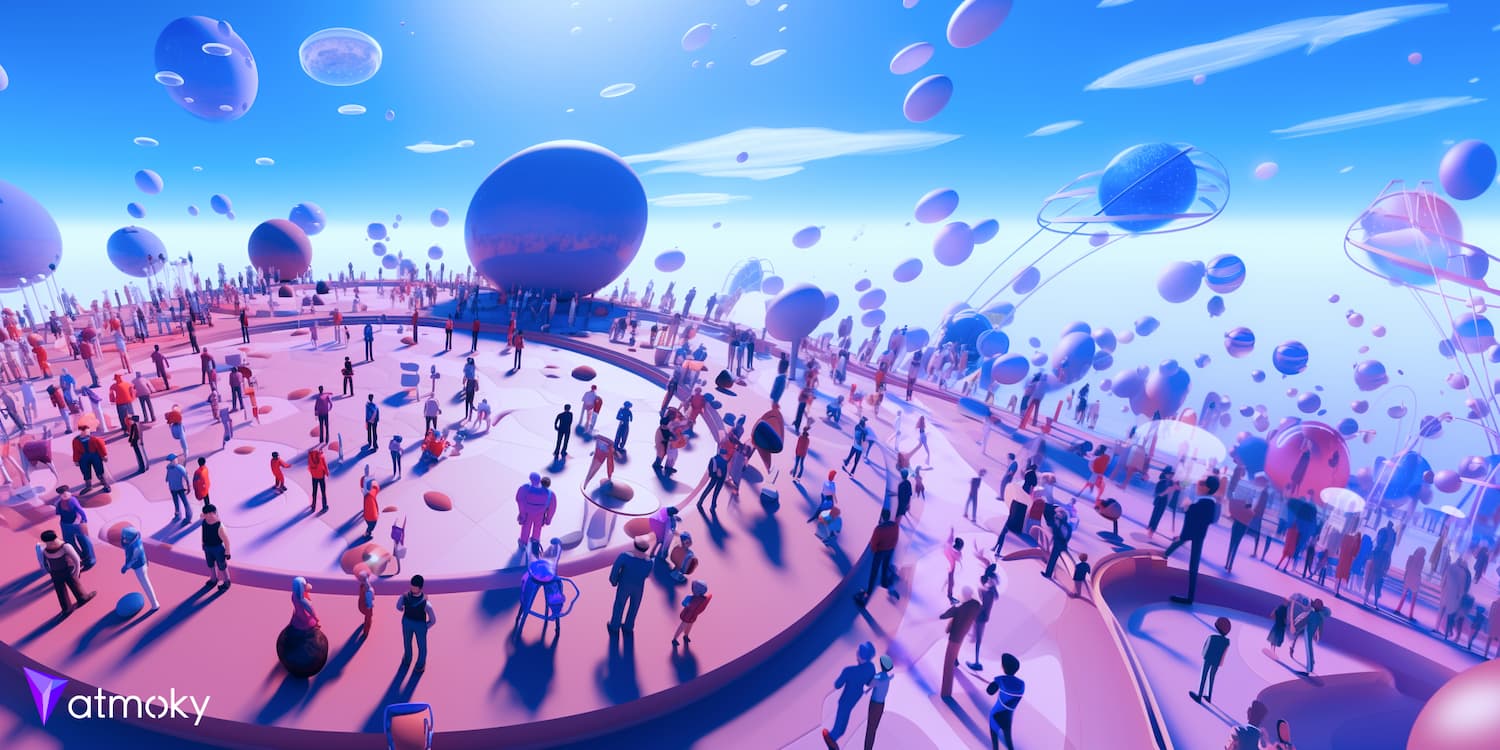
Best practice already in use
Arrival.Space: The 3d social web platform was in closed beta during the last year and recently announced the official space drop as a result of their cooperation with atmoky.
With this event Arrival.Space expanded its reach and opened up its platform to the public enabling its users to create and edit their own spaces, leave so-called voicies in the spaces, and communicate with friends and followers – all in full 3D audio powered by atmoky. visit arrival.space here
This collaboration illustrates the potential of Spatial Computing bridging the digital and physical realms, offering accessibility and engagement, and supporting customers across various industries.
Spatial Computing is reshaping digital interactions and personalized experiences with atmoky Engage playing a key role in this evolution of spatial audio computing technologies.
Brand Opportunities for spatial computing companies
Harnessing Spatial Computing
As Spatial Computing continues to redefine the boundaries of digital interaction in everyday world, brands have a unique opportunity to harness this technology for enhanced communication and engagement.
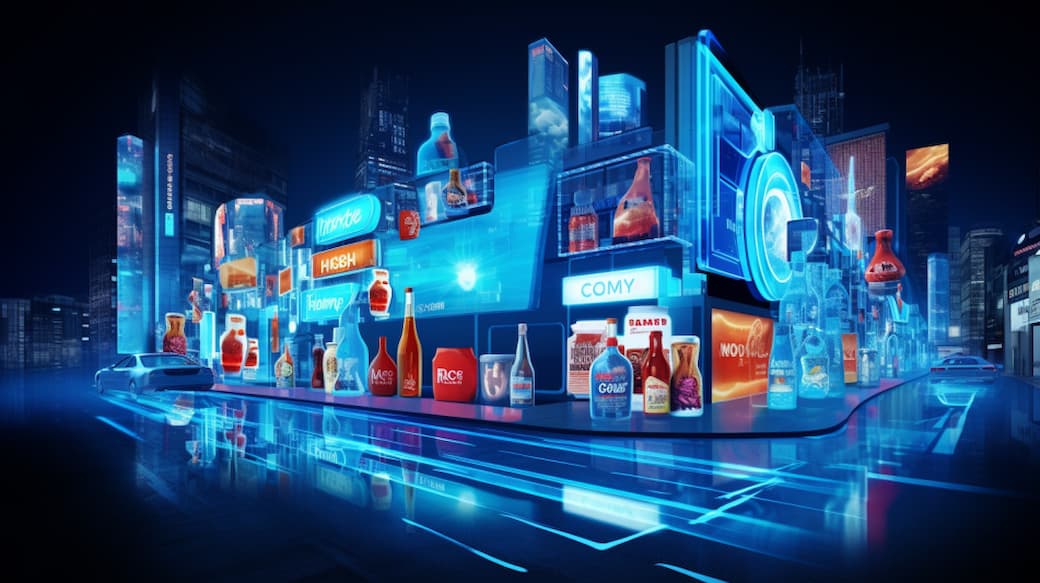
To seize these opportunities effectively, brands can consider the following strategies:
Immersive Brand Experiences
Spatial Computing enables brands to create immersive experiences that go beyond traditional marketing.
Physical meetings offer customizable environments for specific purposes, such as formal discussions in conference rooms or collaborative sessions in breakout areas, but virtual meetings in the metaverse aim to restore that flexibility by allowing tailored virtual spaces that enhance engagement and accommodate various meeting needs.
By leveraging spatial technology, brands can transport consumers into captivating virtual worlds where they can interact with products, services, and brand narratives in three dimensions.
Whether it’s a virtual showroom, a branded gaming experience, or an interactive storytelling journey, Spatial Computing offers a canvas for brands to craft memorable and immersive encounters.
Personalized Interactions in Virtual Meetings
One of the key advantages of Spatial Computing is the ability to personalize interactions at a deeper level. Brands can use spatial data and user preferences to tailor experiences in real-time.
Imagine a virtual home assistant or shopping assistant that understands your style and preferences or an interactive educational experience that adapts to your learning pace.
By leveraging Spatial Computing, brands can create highly personalized and engaging interactions that resonate with their audience.
Multi-Sensory Engagement
Spatial Computing doesn’t limit engagement to just visual and auditory senses. Brands can explore the integration of haptic feedback and other sensory elements to enhance the user experience further.
This could involve tactile feedback in virtual try-on experiences, adding a sense of touch to gaming, or even simulating real-world sensations in training simulations. Multi-sensory engagement provides brands with a powerful tool to create lasting impressions.
Strategies for Effective Branding
Effective branding within Spatial Computing environments requires a thoughtful approach that aligns with the unique characteristics of this medium. Here are some practical strategies for brands looking to make their mark:
Consistent Brand Presence
Just as in the physical world, consistency is key in the Spatial Computing realm. Brands should ensure that their visual and auditory elements, as well as brand messaging, remain consistent across various spatial experiences.
This consistency reinforces brand identity and helps users recognize and connect with the brand, no matter where they encounter it.
Storytelling in 3D
Spatial Computing provides brands with an opportunity to tell their stories in three dimensions. Instead of relying solely on text and images, brands can use spatial technologies and narratives to immerse users in their stories.
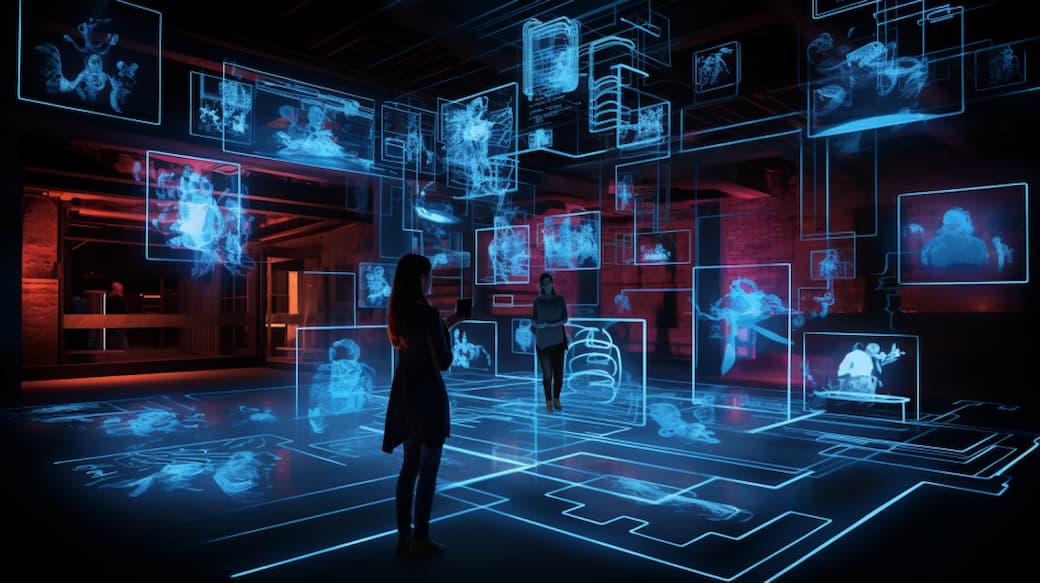
Whether it’s the journey through a brand’s history, a 3D exploration of product features, engaging employee training experiences or an interactive tour of brand values, storytelling in 3D creates a deeper connection.
Interactive Brand Touchpoints
Spatial Computing environments offer interactive touchpoints that brands can leverage to engage users actively. Brands can create gamified experiences, interactive product demos, and participatory events that encourage users to become active participants in the brand’s narrative.
These touchpoints foster engagement and leave a lasting impression.
In the next section, we’ll delve into specific examples of how brands are successfully integrating Spatial Computing into their communication strategies, providing inspiration for those looking to embark on their own spatial computing work branding journey.
The Future of Spatial Communication
Transformative Potential
Spatial Communication holds the promise of reshaping how we connect and interact with geographically dispersed needs:
-
Seamless Integration: Expect a seamless blend of physical and digital realms, enriching our everyday experiences.
-
Enhanced Collaboration: Remote collaboration will become more immersive, fostering genuine connections among individuals and industries.
-
Revolutionizing Education: Learning will be more engaging and effective through interactive 3D models and simulations.
Emerging Trends
Exploring opportunities that will shape Spatial Communication:
-
Metaverse Environments: The rise of metaverse worlds where brands and individuals interact in shared virtual spaces.
-
Personalization: Tailored experiences driven by spatial data and AI algorithms will become the norm.
-
Accessibility and Inclusivity: Innovations will make spatial experiences more accessible and inclusive for all.
In summary, Spatial Communication’s future is bright, promising to revolutionize our communication, collaboration, learning, and connectivity, offering transformative experiences and opportunities for brands and individuals.
Need help to make this new era of spatial computing technology work for you?
Let's communicateRelated Articles
Video Call from the Future with Spatial Audio for Zoom, MS Teams, telephony
How Spatial Sound justifies the Audio Metaverse Hype
Thriving Metaverse Concert on Sound Online Platforms and 360 Video
Metaverse Communication with spatial audio in Virtual Meetings
VR Sound Design with Spatial Audio - Gaming, Metaverse and more!